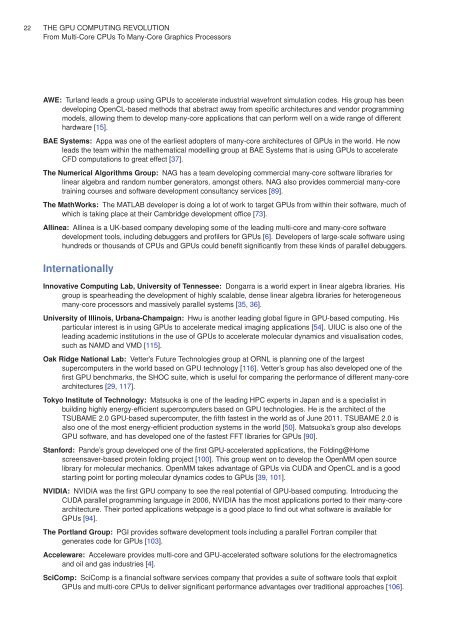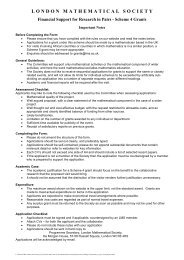The GPU Computing Revolution - London Mathematical Society
The GPU Computing Revolution - London Mathematical Society
The GPU Computing Revolution - London Mathematical Society
- No tags were found...
Create successful ePaper yourself
Turn your PDF publications into a flip-book with our unique Google optimized e-Paper software.
22 THE <strong>GPU</strong> COMPUTING REVOLUTIONFrom Multi-Core CPUs To Many-Core Graphics ProcessorsAWE: Turland leads a group using <strong>GPU</strong>s to accelerate industrial wavefront simulation codes. His group has beendeveloping OpenCL-based methods that abstract away from specific architectures and vendor programmingmodels, allowing them to develop many-core applications that can perform well on a wide range of differenthardware [15].BAE Systems: Appa was one of the earliest adopters of many-core architectures of <strong>GPU</strong>s in the world. He nowleads the team within the mathematical modelling group at BAE Systems that is using <strong>GPU</strong>s to accelerateCFD computations to great effect [37].<strong>The</strong> Numerical Algorithms Group: NAG has a team developing commercial many-core software libraries forlinear algebra and random number generators, amongst others. NAG also provides commercial many-coretraining courses and software development consultancy services [89].<strong>The</strong> MathWorks: <strong>The</strong> MATLAB developer is doing a lot of work to target <strong>GPU</strong>s from within their software, much ofwhich is taking place at their Cambridge development office [73].Allinea: Allinea is a UK-based company developing some of the leading multi-core and many-core softwaredevelopment tools, including debuggers and profilers for <strong>GPU</strong>s [6]. Developers of large-scale software usinghundreds or thousands of CPUs and <strong>GPU</strong>s could benefit significantly from these kinds of parallel debuggers.InternationallyInnovative <strong>Computing</strong> Lab, University of Tennessee: Dongarra is a world expert in linear algebra libraries. Hisgroup is spearheading the development of highly scalable, dense linear algebra libraries for heterogeneousmany-core processors and massively parallel systems [35, 36].University of Illinois, Urbana-Champaign: Hwu is another leading global figure in <strong>GPU</strong>-based computing. Hisparticular interest is in using <strong>GPU</strong>s to accelerate medical imaging applications [54]. UIUC is also one of theleading academic institutions in the use of <strong>GPU</strong>s to accelerate molecular dynamics and visualisation codes,such as NAMD and VMD [115].Oak Ridge National Lab: Vetter’s Future Technologies group at ORNL is planning one of the largestsupercomputers in the world based on <strong>GPU</strong> technology [116]. Vetter’s group has also developed one of thefirst <strong>GPU</strong> benchmarks, the SHOC suite, which is useful for comparing the performance of different many-corearchitectures [29, 117].Tokyo Institute of Technology: Matsuoka is one of the leading HPC experts in Japan and is a specialist inbuilding highly energy-efficient supercomputers based on <strong>GPU</strong> technologies. He is the architect of theTSUBAME 2.0 <strong>GPU</strong>-based supercomputer, the fifth fastest in the world as of June 2011. TSUBAME 2.0 isalso one of the most energy-efficient production systems in the world [50]. Matsuoka’s group also develops<strong>GPU</strong> software, and has developed one of the fastest FFT libraries for <strong>GPU</strong>s [90].Stanford: Pande’s group developed one of the first <strong>GPU</strong>-accelerated applications, the Folding@Homescreensaver-based protein folding project [100]. This group went on to develop the OpenMM open sourcelibrary for molecular mechanics. OpenMM takes advantage of <strong>GPU</strong>s via CUDA and OpenCL and is a goodstarting point for porting molecular dynamics codes to <strong>GPU</strong>s [39, 101].NVIDIA: NVIDIA was the first <strong>GPU</strong> company to see the real potential of <strong>GPU</strong>-based computing. Introducing theCUDA parallel programming language in 2006, NVIDIA has the most applications ported to their many-corearchitecture. <strong>The</strong>ir ported applications webpage is a good place to find out what software is available for<strong>GPU</strong>s [94].<strong>The</strong> Portland Group: PGI provides software development tools including a parallel Fortran compiler thatgenerates code for <strong>GPU</strong>s [103].Acceleware: Acceleware provides multi-core and <strong>GPU</strong>-accelerated software solutions for the electromagneticsand oil and gas industries [4].SciComp: SciComp is a financial software services company that provides a suite of software tools that exploit<strong>GPU</strong>s and multi-core CPUs to deliver significant performance advantages over traditional approaches [106].



